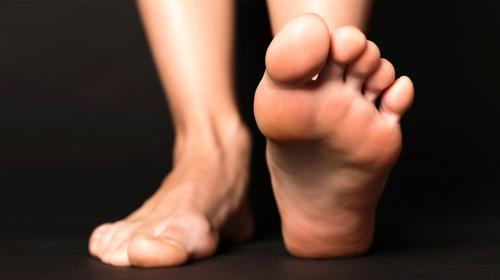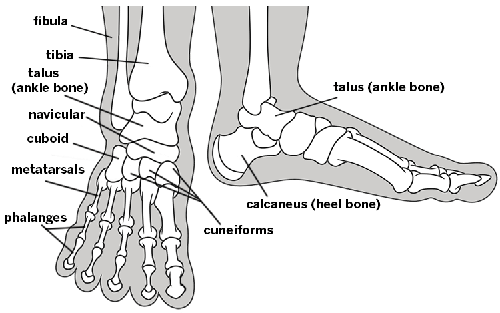Pain on the Outside of the Foot
Pain on the outside of the foot is a common problem that makes walking and standing problematic. Mostly, foot pain is felt before, after, or even during activities such as walking, racing and performing any other strenuous exercise. Some of the main symptoms are a pain on the outside of the ankle, swelling, and difficulty in walking, foot instability, and susceptibility to ankle pain and tenderness in the foot muscles. Pain on the outside of the foot is synonymous with lateral foot pain. Inflammation of the muscles of the ankle joint or the tendon is the main cause of the pain, while some of the other causal factors are the presence of small cracks in the foot bones and arthritis as well. On the other hand, pain on the inside of the foot relates to muscles and tendons on the inside of the foot and the ankle. It is advisable to rest your legs until you can figure out the primary cause of the pain to avoid inflicting more injuries on yourself.

Common Causes and Treatment
There are different ways in which pain on the outside of the foot can be treated, but the first step should be a recognition of the causal factors. The treatment option recommended by the doctor will rely on the outcome of diagnosis. To diagnose pain on the outside of the foot, a doctor will perform a physical examination, check on the mobility and the stability of the foot, as well as other factors. Cause of pain on the outside of the foot can be divided into common and rare factors:
1. Common Causes
A. Stress Fracture
The stress fracture is one of the main causes of pain on the outside of the foot. In most cases, a stress fracture is caused by bruising of one of the bones in the foot due to overuse. Stress fracture commonly affects athletes and soccer players. It occurs when you change the activity your foot is used to, by switching to another suddenly. It can also be caused by intense exercises, such as jumping while playing basketball or volleyball, making the foot to hit the ground frequently.
The following are some of the tips that will help you avoid getting a stress fracture; it would be necessary to do the following:
- Ensure that the shoes you wear provide you with enough support.
- Ensure that you wear shoes that are not too tight, and they should have a wide toe box.
- Engage in some warm up before getting into exercising to prepare the foot bone for more strenuous exercise.

B. Ankle Sprain
An ankle sprain occurs when the ankle joint, which connects the foot with the lower leg, gets injured. It's a natural occurrence that occurs when you plant your foot in an awkward way, causing the joint to carry unusual weight. The unusual weight on the ankle causes injuries to the tendon muscle. The first step in the treatment of stress fracture is rest. Since it is not possible to rest completely because of a few activities which you must attend, you can support yourself with a walking boot along with cast and crutches. The assistive devices help in resting the injured area by limiting the weight on the joint. Physical therapy is also helpful in increasing muscle strength and its flexibility.
C. Peroneal Tendonitis
Peroneal tendonitis refers to the inflammation of the peroneal tendons running on the outer side of the ankle. This problem is mostly caused by overuse of the peroneal tendon making to rub against the bone causing inflammation. It can be treated by avoiding strenuous activities and resting the foot.
D. Arthritis
Arthritis is also a common cause of the Inflammation of the tissues in the joints which finally leads to pain. In most cases, it is not possible to avoid arthritis, but its risk factors can be reduced by quitting smoking, ensuring that you have a healthy weight and that the shoes you wear offer enough support.
2. Rare Causes and Available Treatment Options
A. Rare Causes
- Cuboid Syndrome
Cuboid Syndrome occurs when one of the small foot bones is dislocated from its normal position. The dislocation might be caused by other injuries, such as ankle sprain and repetitive strains. The best method of treating cuboid Syndrome is through the use of RICE method which brings out four possible ways of easing the pain. Rest your foot, Ice the foot regularly for periods of about twenty minutes, Compress the ailing foot with bandage elastic then Elevate the foot to a height that is above the heart level. - Tarsal Coalition
Tarsal coalition refers to the abnormal connection of more than one bones in the foot. The bones affected are called the tarsal bones, and are located at the back of the foot and the heel. In some cases, this condition is present at birth, but its signs are seen sometimes in the adolescence age. The condition causes the foot to become painful and stiff, making daily activities a struggle. One of the main ways of treating this condition is resting by keeping off any strenuous activities, and the use of steroids. Surgical instruments can also be used in cases where the mentioned nonsurgical methods fail to work.
B. Treatments for Rare Symptoms
- Medication. When suffering from the mild side of the foot pain, you can opt to rest and buy some drugs that are helpful in reducing the swelling and relieving the pain in your foot. You may purchase over-the-counter drugs, but in more severe cases it would be advisable to consult the physician for stronger anti-inflammatory medications.
- Physical Therapy. In some instances, the medication prescribed by the physician may not work out effectively. In such a case, it would be advisable to undertake physical therapy with the aim of relaxing the muscles, improve the flow of blood and eventually assist the foot to heal faster and correctly. the doctor or physiotherapist may instruct you to use stabilizers to protect and support the ankle.
General Tips in Relieving Foot Pain
Pain in whichever part of the foot is an inconvenience, because it makes a person unable to handle his or her daily activities normally. Pain leads to suffering and lack of comfort and being unable to sleep. It is therefore important to exhaust all the possible ways of avoiding any of the factors that might lead to pain in any part of the foot, and also develop possible ways of relieving it in case it has already stricken you. In conclusion, the use of appropriate shoes and strengthening of the calf muscles can greatly help in relieving foot pain, for the simple reason that being in the right shoes offers the much-needed support for your foot. Tight and narrow shoes may cause foot problems, and it is, therefore, advisable to wear shoes with a wide toe box, flat soles and with strong support mechanisms. The calf muscles, on the other hand, can be strengthened by exercising your legs regularly.
YOU MAY LIKE
-
How Much of Our Brain Do We Use: Best Tips for You
-
Top Causes and Tips for Electrical Injury
-
Pain in the Back of the Head? Let’s Dig It Deeper!
-
Best Ways to Treat and Prevent a Migraine
-
Lump on the Back of Head - Is It Dangerous?
-
Wonder Why You Often Fall Asleep When Sitting Down?
-
Is a Headache on Top of Head Bothering You? - Causes and Home Remedies
